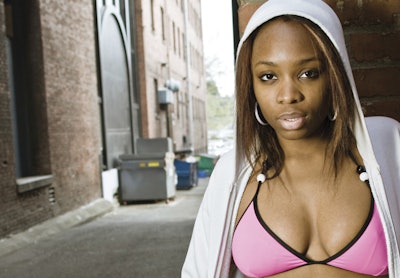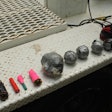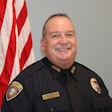 Photo: iStockphoto.com
Photo: iStockphoto.com
Picture a frightened 13-year-old girl selling drugs on a street corner earning money to feed her siblings. She's terrified that if she doesn't her already crumbling family will be separated. One day a good-looking young man who buys drugs from her expresses concern for her safety. He says she can live with him and he'll take care of her and protect her family. As you might have guessed, it turns out his offer is too good to be true.
Soon, the man she thought was her boyfriend and protector is selling her for sex to make money for his gang. She is stuck in "the game" for more than five years and spends more time in jail than the sex trafficker she lives with because she's seen as a criminal instead of a victim. She's so hardened and psychologically manipulated by her captor that it would be difficult to identify her as someone who needs and seeks help.
This is a true story, and it's unfortunately not uncommon. Now, law enforcement agencies have started to recognize that most prostitutes are victims who were brought into a life of trading sex for money when they were young and impressionable, and they don't know how to escape.
Prostitution is, as they say, the oldest profession. But now gangs are getting in on the action in a big way. Their already established tricks for luring lonely kids into their ranks are also extremely effective in recruiting girls as young as 12 for the sex trade.
Gangs have dabbled in prostitution for years. But it was more common for a pimp who was also a gang member or gang affiliate to operate on his own and use his gang ties to intimidate his prostitutes and protect his interests. Now entire sets of gangs are running larger prostitution rings to help fund their other illegal businesses, including sales of illicit drugs and firearms. And in at least one recent case in San Diego, gangs are working together to run large-scale operations in multiple cities across the country.
A Growing Trend
A recent study by the Urban Institute used data from 2007 to show the revenue generated by sex trafficking in eight major U.S. cities: Atlanta, Dallas, Denver, Miami, San Diego, Seattle, Washington, D.C., and Kansas City, Mo. According to "Estimating the Size and Structure of the Underground Commercial Sex Economy in Eight Major US Cities," sex trade revenue dwarfed the amount of money being made on drug and firearm sales, respectively, in those cities. The numbers were from seven years ago. But the study's researchers also interviewed law enforcement officers about current trends in 2014, and gangs came up repeatedly as a new and growing concern in the world of sex trafficking.
"We were surprised to find that even in cities that are taking active strides to investigate and prosecute these crimes, law enforcement felt they were missing the resources, political will, and public understanding to fully attack the problem," said study lead author, Meredith Dank. "Our talks with offenders confirmed this. They spoke of widespread pimping and sex trafficking taking place across the country, but said few get arrested, charged, or locked up for it."
However, agencies across the country are working to change that. This past year the Northern Virginia Human Trafficking Task Force, which had operated informally, received funding from the Department of Justice to operate formally for the next two years.
Task force member Det. Bill Woolf also runs the Human Trafficking Unit at the Fairfax County (Va.) Police Department. He works closely with local non-governmental groups to help victims and spread awareness, and hopes the task force's collaboration will succeed and serve as a model for other agencies. He wants to continue being able to focus full-time on crimes against people who are effectively modern-day slaves. This includes girls prostituting themselves for gangs.
According to a U.S. attorney in Virginia who works with the Northern Virginia Human Trafficking Task Force, murders and other violent crime cases among members of the Mara Salvatrucha, or MS-13, gang in Northern Virginia began to die down, and it wasn't clear why. He believes the gang shifted its attention to sex trafficking as a more reliable revenue source. Around 2008 and 2009, gang investigators in the area became aware of gangs' involvement in the sex trade. But that was only when they started to ask gang members questions about the topic. It's difficult to know how long before that the involvement began.
Woolf first worked a case involving gang-controlled sex trafficking in 2011. MS-13 was the gang running this operation in the D.C. Metro area. Since then, Woolf has seen sex trafficking operations run by all three types of gangs: transnational such as MS-13 and 18th Street, national such as Crips and Latin Kings, and various local crews unaffiliated with larger gangs. But all of them, whatever the race or type of gang, recruit in the same way, he says.
Gang Targets
Gang members look for certain types of girls to bring into their operations. They know how to prey on people looking for a place to belong and they use psychological manipulation to win them over and keep them under their control.
It's important to understand that these girls are not willingly committing crimes. Gangs victimize them, says Elizabeth Scaife, training director at non-profit Shared Hope International. She teaches law enforcement officers how to identify victims and how to respond appropriately when contacting them.
"Traditional pimps have targeted girls with low self-esteem, and the pimp has fulfilled the father figure role. But the gang seeks to replace a person's entire family, so the level of indoctrination is much deeper," explains Woolf.
A poor 13-year-old desperate to feed her siblings because her parents can't or won't is a natural target. But any girl who is disconnected from her family could fit the profile. "It cuts across all races, ethnicities, genders, and, shockingly, socio-economic factors," Woolf says. "We've had cases where the parents were making more than a million dollars a year; they're affluent and influential."
Preconceptions about the types of girls who join gangs and the sex trade can make it easier for families and entire communities to not see what is happening until girls are already absorbed into the gang culture and working the streets. "Sometimes they're living at home and performing sex acts on the weekends or during evenings," says Scaife.
"Gang-recruited victims are targeted because they're more loners, still in school and living at home," Scaife adds. A girl may be recruited by another female to attend a gang-hosted party during school hours, what's often called a skip party. Because it happens during the day, it's easy to hide from parents. It often involves drugs and alcohol and makes a gang seem fun and exciting.
"Then they introduce that, 'We have access to money, so we do what we want, we get respect in the community, we have power and a sense of control. And guess what, this is who we are, and now we've got your back and you're one of us,'" says Scaife.
A girl may feel comfortable around gangs because a family member belongs to one, Scaife says. Or she might start dating a gang member, maybe even meeting him online first. This familiarity opens the door for her to allow gang members to take advantage of her. She may already view herself as property of the gang, and could see having sex with people to benefit her gang family as her duty. It escalates from there.
This type of recruitment is different from the more well established Russian and Chinese sex trafficking rings run by organized crime from these countries. Robert Trent worked in immigration law enforcement for 30 years and is very familiar with the ways they victimize people. While these operations also exploit young women, they prey specifically on people from their countries of origin who they bring to the United States for the purpose of selling them for sex, he says. They don't recruit Americans.
Getting Girls Help
Law enforcement has traditionally picked up prostitutes, charged them, jailed them, and released them to return to the sex trade. But that's no longer the norm. It's much more effective to recognize that the girls gangs have been prostituting are victims and should be treated as such. It helps them, and it helps officers and prosecutors catch the people responsible.
This is what Scaife of Shared Hope International tries to impart to the officers she trains. "My goal is to lay such a strong and deep foundational knowledge about this that they have a natural compassion and understanding, so they're not immediately put off by the surface aspects, which are the attitude, the defiance," she says.
These girls don't self-identify as victims. Most have been convinced by their traffickers and through experience that no adults or police officers can be trusted to help them, so they'll come across as belligerent or refuse to talk. They're afraid of their traffickers and don't believe anyone can get them out of the situations they're in. That's why it takes training to recognize their plight and help them get out.
A girl who believes you're on her side is much more willing to testify against the gang members who took advantage of her. In fact, you'll have difficulty getting her to speak to you at all unless you make the effort to break through her façade.
Instead of putting her in a standard interview room with a cold table and chairs, put her in a "soft room" with a sofa to sit on and give her a soda and a hamburger. You'll be amazed at how much something so simple will mean to one of these girls, says Lt.Dan Pratt of Long Beach (Calif.) PD's Vice Investigations. "And then when our detectives speak in their terminology they get that we understand," Pratt says. "Once we can communicate that and how we can help them, then they open up."
He believes that law enforcement viewing prostitutes as victims has made a major impact for the better. But it goes beyond offering food and a kind word to victims. It's also important for all first responders to know how to recognize the signs of human trafficking so they can respond appropriately. "We don't want an officer to respond to a domestic violence or child abuse call and not recognize it as human trafficking," Pratt says.
And being aware of these victims' possible vulnerabilities, such as abuse at home they may be running away from, helps law enforcement meet their needs. Placing a runaway back in the home isn't always the best solution, yet it was the only way it was done in the old days. "Since then we've clued in to those things and become fully aware and partnered with non-governmental agencies," Pratt says. "The best thing we do is investigate to find the root cause of why this person is on the street to begin with."
The Long Beach Police Department and many other agencies work with non-governmental agencies to provide a range of services to girls so they can leave prostitution. "They help them reach their ultimate goal, whether it's getting a job, or going to school, or going back home," Pratt says. A drug or alcohol abuse program is usually one of the services needed to help victims get out and stay out of sex trafficking.
Because most gangs run narcotics operations, they can use their easy access to drugs to keep girls under control. In the case of the Northern Virginia Task Force sting Woolf was involved with, the sex traffickers often "paid" girls by giving them a fix of whatever drug they were addicted to and simply kept all of the cash for the gang.
Drugs and alcohol help these victimized girls numb themselves so that they can somehow cope with what they're being forced to do, sometimes servicing more than 20 johns in a day, says Scaife.
Sex traffickers control girls by giving them only what they need, not what they want. If the trafficker always keeps them wanting, they'll stay, they reason. It falls to law enforcement to break that cycle by helping the victims and putting away the traffickers.



















